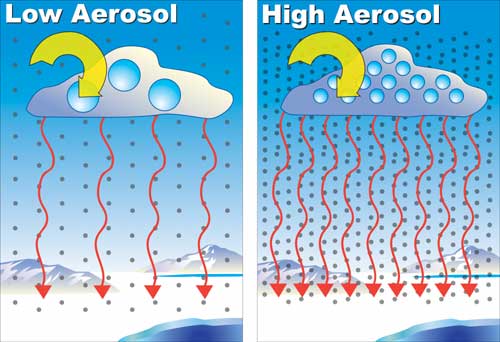Aerosols In Many Arctic Clouds Warm Up Ground Surface
January 26, 2006
UPTON, NY - Enhanced aerosol concentrations increase the amount of thermal energy emitted by many Arctic clouds, according to scientists supported by the Department of Energy's (DOE) Atmospheric Radiation Measurement (ARM) program. In research published in the January 26 issue of Nature magazine, Brookhaven National Laboratory scientist Andrew Vogelmann and lead-author Dan Lubin of the Scripps Institution of Oceanography conclude that the increase significantly affects the Arctic energy balance.
Scientists believe that the warming of the Arctic climate and decreases in the area and thickness of sea ice are caused by greenhouse gas warming. The Arctic region also experiences large periodic influxes of aerosols originating from the industrial regions to the south. Using data from the DOE ARM Climate Research Facility in Barrow, Alaska, Vogelmann and Lubin determined that enhanced aerosol amounts can make clouds emit more thermal energy to the surface. In an aerosol-cloud process, increased aerosol concentrations cause the cloud droplets to become smaller and, within clouds of fixed water amounts, more abundant. Vogelmann and Lubin discovered that this process makes many clouds more opaque and emit more thermal energy to the surface, by an average of 3.4 watts per square meter, which is comparable to that by increased greenhouse gases.
"Before this study, we didn't really know how this process would affect emission of thermal energy from the cloud to the surface," Vogelmann said. "It's now clear that it contributes significantly to warming at ground level."
Because sunlight is generally weak in the Arctic, the clouds, via their emission of thermal energy, normally exert a net warming on the Arctic climate system throughout most of the year, except briefly during the summer.
"We focused on thin, single-layer clouds that are close to the surface, with temperatures that would favor them containing liquid water," said Vogelmann. "Arctic researchers recently discovered that liquid water largely governs Arctic cloud radiative properties during spring and summer, with liquid water being found in clouds at temperatures as low as -34 C."
"We have concluded that the aerosol-cloud process - called the first aerosol indirect effect - operates in the clouds we studied, and results in a greater downward thermal emission from the cloud," Vogelmann said. "Its contribution to the surface warming is comparable to that by the so-called greenhouse effect."
"The Arctic is showing the first unmistakable signs of climate warming caused by human activities, in the form of rapidly retreating and thinning sea ice," Lubin said. "This rapid climate change in the Arctic may have profound implications for both fragile ecosystems and unique modes of human habitation. Our study illustrates how human activity can influence Arctic climate in more than one way, by changing the way clouds warm the climate, in addition to the carbon dioxide increases. It is also another example of human industrial activity's surprising impact on remote polar regions."
 enlarge
enlarge
In a process known as the first aerosol indirect effect, enhanced aerosol concentrations cause the droplets in a cloud to be smaller and more numerous within a cloud of fixed water amount. This study found that this process can make the clouds more opaque and emit more thermal energy to the surface.
The key to understanding the thermal impact of this aerosol-cloud effect lay in the long-term measurements made at the DOE ARM Climate Research Facility, which has an extensive suite of sophisticated instruments for measuring the surface energy balance and atmospheric properties. These data were used with aerosol measurements made next door by the National Oceanic and Atmospheric Administration (NOAA) Climate Modeling and Diagnostics Laboratory (CMDL) facility. Six years of data were used to determine the impact of aerosol on Arctic clouds and the surface thermal energy budget.
The research was supported by DOE's Office of Biological and Environmental Research.
2006-10413 | INT/EXT | Newsroom










